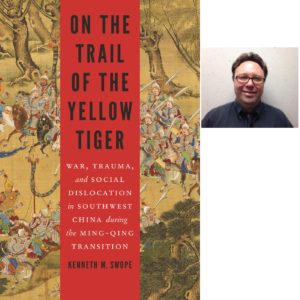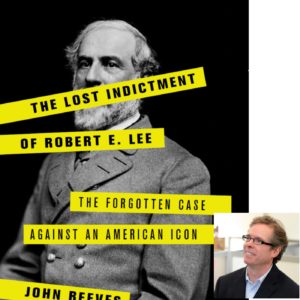Podcast: Play in new window | Download
Subscribe:

Dr. Ken Swope is a history professor at the University of Southern Mississippi. He studies and writes on the imperial and military history of East Asia. In this podcast, I interview him about his upcoming book On the Trail of the Yellow Tiger: War, Trauma, and Social Dislocation in Southwest China During the Ming-Qing Transition.
1:27 – Dr. Ken Swope discusses how he started writing history. He studied Chinese history from the 16th and 17th century and has mainly written on that period.
2:47 – He discusses the origination of the current book which grew out of his research on previous books on Chinese history. He’s used obscure materials for research that not many people know about.
4:32 – The subject of this book is a person nicknamed the Yellow Tiger, a legendary figure associated with peasant rebellions against the Ming Dynasty. Follow on rebellions were very bloody. His own adopted sons become the defenders of the Ming Dynasty against the Manchus.
7:32 – Ken Swope then discusses what made the Ming Dynasty weak and susceptible to rebellion. Much was written in his previous books. Court intrigue contributed to the weakness. At the same time the Manchus were on the rise in the early 1600s. They also suffered climate change that caused epidemics and famine. Many rebels had been part of the postal service and when they were laid off they became bandits.
11:47 – Many of the peasant rebels were literate. China had very high literacy rates in this historical period. Silver from the Americas helped feed Chinese trade.
13:50 – Communications at the time was weak and the rebels could hide in places the government couldn’t reach. The Mings also had been involved in many wars and were taxing people too much. But they still had a huge army in comparison to the rebels. They also used eunuchs to collect taxes for the Emperor.
17:13 – Ken Swope says that the main theme of the book is the effects of war on society. The trauma and changes it creates. Uprisings in the southwest area of China are common and they experience lots of conflict and disruption.
19:12 – He had many resources to go to for research. There were many collected records for the period. Many people wrote things down at the time. Memoirs, diaries, battlefield reports, imperial proclamations, foreign accounts, “wild” histories, and family chronicles.
Lots of the materials were compiled during the Ching period. Other items were compiled in the 19th and 20th centuries.
22:47 – He came across some interesting artifacts. He found an interesting [tomb] grave in an obscure area. He found a public park with steles that had pictures of old heroes and their execution sites. He found the spot where the last Ming Emperor was executed. There was also a big naval battle in 1647 and many artifacts, maybe 30,000, have been found in the river where it happened. Ken Swope did a paper on this find.
27:32 – The old documents are written in classical Chinese. Taiwan and Hong Kong still use traditional characters. It’s a difficult form of Chinese to read. Some of the manuscripts are handwritten which makes them more difficult to read.
30: 10 – Ken Swope most enjoyed looking at documents that only a handful of people have ever read in 400 years. The battlefield sites were also very interesting to see including a famous pass to Chongching. The weapons and historic homes were interesting to see. But there’s not a lot of battlefield preservation in China.
32:18 – He was most surprised by the frank discussions that people had at the time about life in China. People were worried about the poor and being away from home. There were also many rural folk tales about ghosts and evil spirits. During times of chaos people say the spirit world is out of hand too.
37:00 – Both armies created and read omens during fighting. For example, before Chungdu fell, they claimed all the turtles left the city. But the government also tried to discourage belief in omens.
38:45 – The Jesuit accounts often tried to put a positive spin on the events they were witnessing. Taoism was prominent in this time too. But the people accepted all thoughts and religions together.
40:53 – The biggest challenge he had in researching was figuring out motivations and keeping all the people straight. There were dozens of major players involved in the events he wrote about.
42:42 – He was impressed by how many people thought in terms of a national or regional context and were fighting for something bigger than themselves. Characters will fight to the death for an ideal. This includes female warriors.
44:29 – he wants this book to connect China to the global problems happening in the 17th century. He also wants to increase knowledge about figures who are heroes and famous in China today. China also has more sources for 17th century warfare than anywhere else in the world.
46:30 – Ken Swope didn’t have big problems getting the book published. His success with previous books helped get this one published. Getting your name out there will help get your work published.
48:35 – The next book is a biography of General Zuo. He was a 19th century general who fought the rebellions during this period. He crushed many massive Muslim rebellions and modern people are curious how he accomplished this.
51:23 – His works can be found on Amazon. He’s on Nebraska Press, Oklahoma Press and Routledge. British bookstores carry is books too and so does the British Museum. There’s a lot of interesting Chinese military history to study.
Links
http://www.nebraskapress.unl.edu/nebraska/9780803249950/
For more “Military History Inside Out” please follow me on Facebook at warscholar, on twitter at Warscholar, on youtube at warscholar1945 and on Instagram @crisalvarezswarscholar
Guests: Ken Swope
Host: Cris Alvarez
Tags: military history, chinese history, chinese war, chinese military, peasant rebellion, rebellion, 17th century, ching, ming, manchu, ghosts, spirits, spirit world


